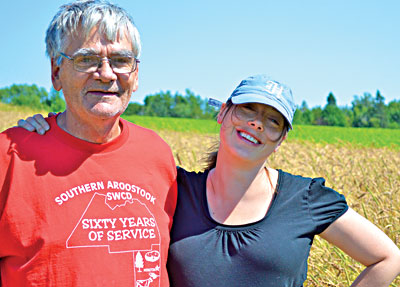 |
| Matt Williams and his daughter Sara Williams Flewelling grow MOFGA-certified organic grains in and around Linneus, Maine. English photos |
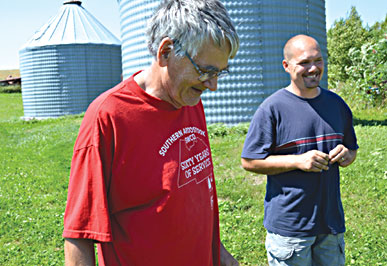 |
| Matt Williams with MOFGA’s John Chartier and two of Williams’ storage silos |
By Jean English and John Chartier, MOFGA
Starting or transitioning to an organic farm on a small scale takes dedication – and a good education and great observation and marketing skills.
Going organic on hundreds of acres? That can be a significant financial and personal risk.
Increasingly, though, due to consumer demand, farmers in Aroostook County are experimenting and succeeding with organic potatoes and grains, despite the added risk of having a weedy field at first or being the butt of the local coffee shop jokes.
This article features three large farms in The County that are contributing to the 200 percent growth in organic grains there. Three years ago, three Aroostook County farms were growing a total of 325 acres of organic grain; in 2015, 10 farms were growing about 1,000 acres. Additionally, the farms featured here have invested or are investing in grain cleaning, drying and storing capabilities, which is critical to be able to sell at least a portion of the crop as food-grade (for human consumption). Food-grade brings more income than feed-grade (for livestock).
Aurora Mills & Farm
At Aurora Mills & Farm LLC in Linneus, Maine, near Houlton, Matt Williams and his daughter Sara Williams Flewelling grow MOFGA-certified organic grains on about 210 acres, including their home farm of 50 acres and other, rented land. The two do almost all the farming, and they store and mill all their grains, with employees working in their mill. They also process grain from contracted growers and combine grain for various growers.
Previously a grain agronomist with the University of Maine Cooperative Extension, Matt started growing organic, food-grade wheat in 1997 and started his milling operation in 2001 to meet the needs of the small number of bakers seeking Maine grains then. He and his wife, Linda, are now advisors for The Northern New England Local Bread Wheat Project (https://umaine.edu/localwheat/).
Sara grew up in Linneus and then worked in landscape design and sales in Washington, D.C. – big jobs for “a high powered crowd.” She returned to the farm three years ago. “Maine’s not something that leaves you,” she says.
They grow winter and spring wheat, spelt, peas, oats, clover, buckwheat and garlic. In 2015, for the first time, all of their crops were cash crops, including their rotation and nitrogen-fixing crops. Clover and buckwheat were sold for seed. A state grant for “Expanding Cover Crop Seed Production and Cleaning Capacity within the State of Maine” helped them increase production of cover crops and will enable other farmers to produce more seed.
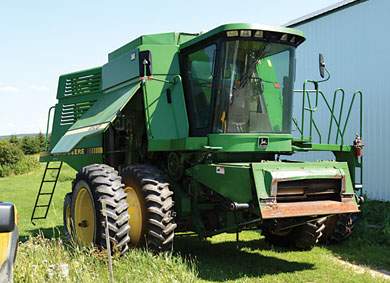 |
| A combine at Aurora Mills & Farm |
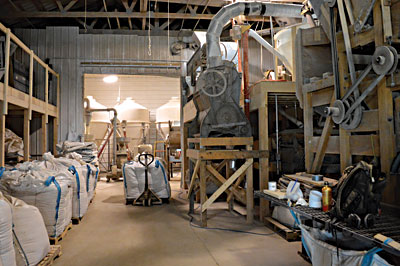 |
| Harvested grains go through some half-dozen machines at Aurora Mills to be cleaned, sorted and further processed. |
“We’re excited to be incorporating buckwheat” into rotations and on transitional (to organic) fields, adds Sara, “because it’s hopefully going to smother weeds.” They harvest buckwheat when about three-quarters of the seed is black, saving the seed for future cover crops and to sell. The year after one transitional field grew buckwheat, Matt and Sara planned to plant no-till organic wheat into the stubble.
Their wheat varieties include ‘A.C. Barrie’ from Agriculture Canada (Matt bought the seed around 2002 and has been replanting it since), ‘Poltavka’ (one of the ancient wheats), emmer, a French heritage called ‘Rouge de Bordeaux’, ‘Maxine’ and durum.
Cultural Practices
“We pay a lot of attention to soils,” says Sara. They amend soils with chicken manure from Casella Organics, which gets the product from a facility in New Brunswick that raises birds on sawdust bedding. They are bringing back a rented field that hadn’t been cultivated in years by spreading wood ash to raise the soil pH and chicken litter for fertility.
The common cereal insects don’t overwinter in their area now, so they don’t do any pest control in the field. “There are no “cides” [pesticides, herbicides, etc.] in our [system],” says Matt. In the processing stage, sanitation controls pests.
They control weeds primarily through optimal planting dates that ensure a good cover of crops to shade weeds; a field of ‘A.C. Barrie’ we visited was underseeded with clover at the tillering stage. When they harvest grain, they remove and burn weed seeds. Mechanical control of weeds, with a Lely cultivator, for example, depends on having the right weather conditions, says Matt. During dry periods, they can kill 80 or 90 percent of weeds through cultivation, he says, but they don’t use the Lely if it’s overcast and rain is predicted.
For quackgrass control, they used to plow and disc and keep the ground open for about a month. “That really isn’t an ideal system,” says Matt, “because [with] ground exposed for a month – one rain event and you’ve lost 200 or 300 years of work by nature.”
A new planter enabled them to switch to a no-till system this year. In one field they applied manure and no-till planted buckwheat and tillage radish. Next year, in early April, they plan to drive their tractor on frozen ground and plant spring wheat there. By shifting to no-till, Matt says they’ll undoubtedly have a new problem that they haven’t anticipated. “When you do farming, you’re selecting your problem.”
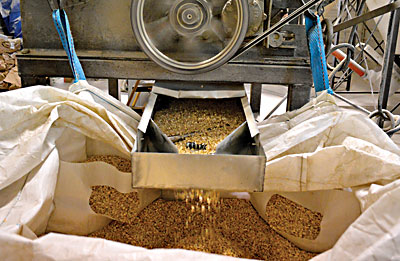 |
| Aurora’s oats in their final processing step |
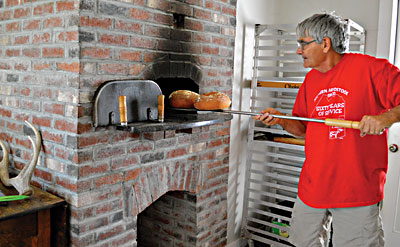 |
| Williams removes a loaf of bread from the wood-fired oven he and Sara built. |
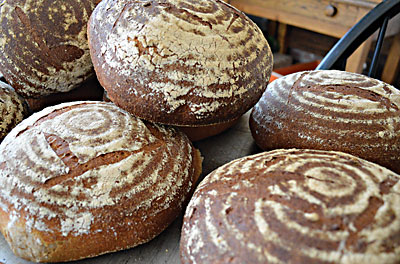 |
| William’s bread, ready to eat! Williams used his ‘A.C. Barrie’ wheat and Russett potatoes chopped in a food processor to make the bread. He prefers using Wayne Marquis’ ‘Yukon Gold’ potatoes when available. |
They try to mimic nature by adding diversity, but they don’t alternate grains and potatoes because Matt believes that fungicides used on potatoes, even organically approved, are bad for the system. “It’s a necessary evil, but most nutrients taken up by a plant are introduced to that plant by fungi in a symbiotic relationship.” He believes yields have plateaued in the potato industry because fungicides have killed those symbiotic fungi. “[Growers] need to increase the time between potato crops,” he suggests; “put a healing crop in, like a clover.” Currently, he says, about half the potato acreage in The County is rotated with barley and about half with oats.
Their rotation is evolving. They rotate grains with clover but are introducing a rotation of wheat followed by peas and oats – and they’re going to switch to crimson clover as an annual crop.
On a field previously in spelt, they disced the soil lightly to beat back quackgrass and then planted 90 pounds of peas and 50 pounds of oats per acre and allowed some residual clover to grow in the field. Oats support peas, which produce better when they grow upright; oats and the following crop of wheat will benefit from nitrogen fixed by bacteria associated with the peas. They’ll use a swather to drop the oat and pea plants into a windrow. After the windrow dries, a pickup head will feed it into the combine to harvest peas and oats at the same time.
Then the seeds go through a cleaning system. Fedco buys any hairy vetch seed that comes with the harvest. In a couple of years, only peas and oats will be harvested, because the farmers are removing grasses from the fields. “If you’re an organic farmer relying on manure,” says Matt, “you’re stimulating the aggressive grasses. For grain farmers, grasses will take your production out, but the broadleaf weeds are not a big deal. They’re more a social problem than anything else.”
Once grains are in the mill, machines separate seeds by weight (with fans), size (with screens) and density (with a gravity table that floats the grain on air). More machinery separates smooth from rough seeds, and yet another machine separates round from not round. “We can separate pretty much everything,” says Matt.
Aurora’s organic grains have never failed to meet milling (food-grade) quality. All their flour has to be under 1 ppm vomitoxin, and they ensure that by getting all their wheat under 1 ppm. (Vomitoxin is a mycotoxin that can be produced on several kinds of grain crops infected by Fusarium fungi.)
Many independent growers who are not processors make food grade only about half the time, says Matt, because they wait too long to harvest and they don’t have their own storage. “It’s got to be dry,” he says. “The culture in Aroostook County was that grain was a necessary evil. No one grew it for money – although most of the wealth in American agriculture has been through grain growing, by far. All the corn, soybeans, wheat, oats [in the Midwest and prairie provinces] … and these potato farmers think, ‘Gee, nobody’s making any money.’ And these [Midwestern] guys are buying 5,000-acre tract farms with 2.5 million worth of equipment on them, and you guys can’t make any money – why? Because you don’t put up a storage [structure]. If you try to sell the grain at harvest, that’s about the worst thing you can do.”
Regarding costs associated with grain production, Matt said a new combine runs about $400,000. “Prices are down now because grain prices are low.”
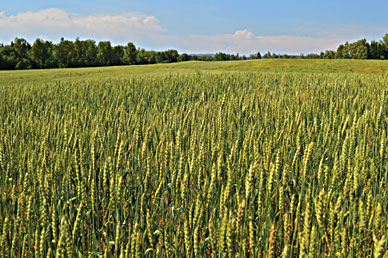 |
| A field of ‘A. C. Barrie’ hard red spring wheat at Aurora Mills & Farm. Sara says it makes Aurora’s star bread flour, and they have been saving its seed since 1999. |
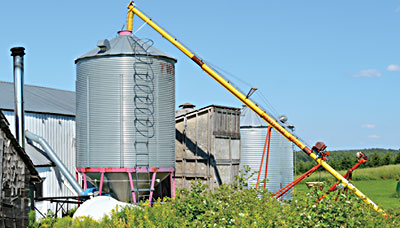 |
| Grain enters this silo at Aurora Mills before it is processed. |
Markets
Most of their grain is for human consumption. “None is for animal feed on purpose,” says Sara, as that would bring a lower price. Of all the Aroostook growers who started raising organic grains in the ’90s, Matt is the only one who has always done food-grade. His wheat, in fact, has “never not made food grade,” he says.
Aurora usually sells all it produces, so Matt and Sara are trying to add 50 to 100 acres each year if they can find the land. “I could probably grow 1,000 acres and be able to sell it (as finished product),” says Matt.
Sara and her husband, Marcus, also are looking for land for their own grain farm. They believe they can afford to bring another 20 or so acres into organic production each year, considering costs of soil improvement and of waiting for the land to be certified organic.
They market through Crown O’ Maine and Grandy Oats, through direct sales to bakeries and through Borealis Breads. “Dad started with Borealis in the late ’90s,” says Sara. “Aurora Borealis! They still have that relationship.”
They also bake in a wood-fired oven that Matt and Sara built, and they sell their bread and bagels at The County Co-op & Farm Store in Houlton. (Sara is on the co-op board.)
In yet another market, Aurora Mills is partnering with Grandy Oats in Brownfield, Maine, to supply 16,000 pounds of organic rolled oats to Boston University campus dining halls.
Crown O’ Maine delivers Aurora’s milled grains in 50- and 3-pound bags to retail outlets, including co-ops. If a co-op is not carrying their product, “ask,” says Sara, “and they can get it, because they all buy through Crown.
“You don’t want to be anonymous,” she says of their marketing. Grandy Oats does a Maine oat bag with them. “It’s our product. Grandy Oats has really nice packaging, and it has our story on the back. They’ve been great because they support organic through and through, and with us they’re increasing their Maine organic.”
The market for organic grain for human consumption is relatively small and is still developing. On the other hand, upper New England produces about 15,000 acres of feed grain, and about 90 percent of that goes to dairy cows, so the animal feed market is relatively stable.
“A lot of people want to have a commodity market and they’ll have commodity prices,” Sara says. “I don’t see it happening within the state of Maine unless conventional potato growers sign on to organic.”
Aurora is probably the third largest organic grain grower in Maine and may be the largest organic wheat grower. It is probably the largest processor of all-Maine organic grain. Others buy grain from Canada, or they buy from Maine but not all organic.
Growing organic grains on a small scale is not feasible, Sara believes, unless you’re in a market such as Portland and you’re selling a niche product such as rare heritage grains. “You need scale or a high-value rotation crop and a market,” she says. “I’m lucky that I got to come back into this.
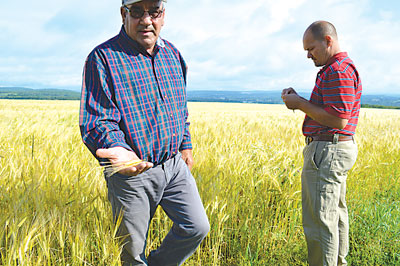 |
| Wayne Marquis (left) and John Chartier inspect barley on August 4, when the plant has finished growing its seed, the berries are full and plants are drying down. |
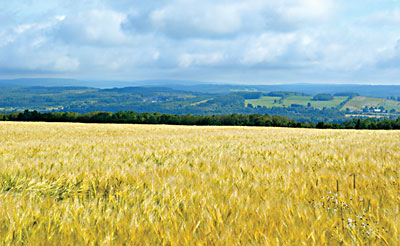 |
| A field of barley at Marquis Farms, with Canadian farms in the background and the St. John River in between |
Marquis Farms
In Van Buren, a two-hour drive north of Linneus, Wayne Marquis of Marquis Farms raises MOFGA-certified organic green legumes, oats, barley, wheat, rye and potatoes. Wayne’s son, Nathan Marquis, who operates the farm’s conventional potato and grain production and sales, also assists Wayne in the daily operations of growing and harvesting the organic products. Eventually Nathan will take over all aspects of the organic portion of Marquis Farms. Wayne’s daughter, Denise Johnson, a stay-at-home mom, also helps on the farm by doing the bookkeeping.
This year Marquis Farms planted, maintained and harvested approximately 1,200 acres of green legumes, grain and potatoes throughout the St. John River Valley, and with the recent purchase of additional land, the farmers plan to expand the acreage in the coming years.
“We’ve been growing potatoes and grain here in Aroostook County for many generations, and our experience has allowed us to develop a solid skill set that enables us to grow superior crops,” says Wayne. “It’s what grows best here in Aroostook County, and we grow it well. The combination of growing potatoes and grain simultaneously works out quite well as it allows for easy crop rotation, a process necessary for maintaining the integrity of the soil.” Potatoes and grain have similar growing times and are planted and harvested around the same time of year, so crop rotation can occur without altering the amount of acreage grown of each product.
Wayne plants his grain crop in mid- to late May using a non-treated seed. The seed is fertilized with Nature Safe Fertilizer 10-2-8 blend when it is planted through the grain seed planter. This allows for greater bioavailability to the grain seed as opposed to dispensing the fertilizer later in the growing season when the grain seed has to compete with weeds. This practice helps control weeds and ultimately helps grow a better grain crop.
“It [Nature Safe] is expensive, but it’s the most effective fertilizer I have found,” says Wayne. He also adds wood ash to the soil in the fall to help maintain the soil pH between 5.8 and 6.0 and to increase his chances of growing a successful grain crop for the next year.
“I cannot stress enough the importance of good crop rotation between grain and potatoes,” he says. “This along with creating a good seed bed is vital to producing a healthy grain crop.”
Wayne describes his crop rotation as a 1:1 ratio of grain to potatoes. The first year he plants his grain and underseeds it with clover. He harvests his grain in the fall and then plows under the clover, creating a green manure. The following year he plants potatoes in these fields. Eventually, due to the acquisition of additional land, Wayne hopes to increase his grain-to-crop rotation ratio to 2:1, i.e., two years of grain underseeded with clover, to one year of potatoes.
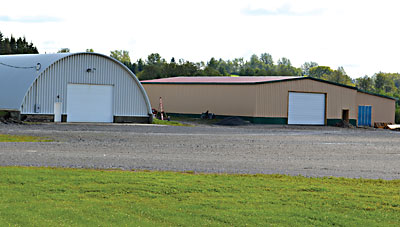 |
| Storage structures at Marquis Farms |
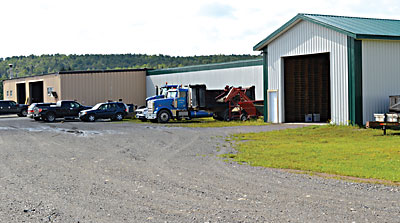 |
| Equipment and potato processing facilities at Marquis Farms |
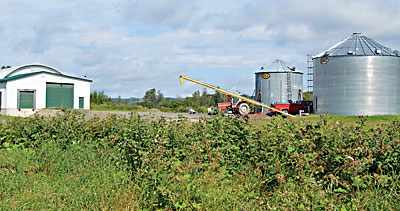 |
| Two silos at Marquis Farms; more are planned. |
As a result of optimal weather conditions in Aroostook County throughout the 2015 growing season, no interventions were required to protect his crop from pests or disease.
Grains are harvested at Marquis Farms in late August to early September. The majority of the grain is sold directly from the field, and the rest is stored in the farm’s grain silos. A total of 25,000 bushels can be stored at one time. With the increasing demand for grain, Wayne plans to build additional grain silos soon.
“It is important to stay current on up-to-date farming practices, especially when farming larger acreage,” says Wayne. “By staying current on evidence-based farming practices, you increase the likelihood of producing high quality grains without any major issues.”
Wayne also attributes some of his success to the increasing consumer demand for organic products in Maine.
“The rise in organic dairy and beef cattle farming as well the organic milling and malting industry has made a huge impact on the organic grain farming business here in Aroostook County.”
All the organic grain grown at Marquis Farms has been sold as feed for cattle in Maine. Wayne hopes that in the future he will be able to raise organic grains suitable for food grade consumption.
In 2015 Wayne also began baling his own organic straw from the harvested grains. He was able to sell this organic straw to dairy and beef cattle farms as well as organic mushroom farms.
Farmers in general face many challenges, but one of the benefits to organic farming at this time is that the market is not as flooded as it is with conventional farming. A significant amount of competition exists among conventional farmers to sell their products, and as a result the price for which they can sell is affected. However, in organic farming, where the supply is less than the demand, farmers have greater control over the price their crops can get.
“The push for organic products in Maine should inspire conventional farmers to convert some of their land to organic production,” says Wayne, “especially since the demand seems to be greater than the supply.”
Benedicta Grain Company
In Benedicta, between Lincoln and Houlton, Jake Dyer, his wife, Hannah, and his father-in-law, Andrew Qualey, have been growing certified organic grains for seed and processing since 2008 at their Benedicta Grain Company.
Previously Qualey grew potatoes here commercially, as did his ancestors, starting with those who came to the land from Ireland in the mid-1800s. Qualey retired from growing potatoes 2006.
Dyer had been running UMaine’s livestock and crops research farm in Old Town in the mid-2000s, when the organic dairy industry was growing significantly, as was demand organic feed grain. Because the Benedicta land had been out of production for a few years, Dyer and Qualey were able to have it certified organic in 2008, when they planted their first barley crop. They increased production of various grains from 34 acres then to about 160 now.
Dyer and Qualey both have off-farm jobs (Dyer with the Maine Potato Board), and Jake and Hannah have two young children, so grain farming is a part-time job that has worked well for their schedules.
Crops
Benedicta now grows barley, soybeans, winter rye, spelt, field peas, buckwheat, clover and tillage radish. The latter three are their main cover crops.
Selecting varieties is a work in progress as they look for those that produce well in their area and have good harvestablility and a market. They got a SARE grant in 2015 to test four pea varieties and to work them into their grain rotations, so this was their first year growing field peas, which seemed to be working well. The crop would probably be sold for animal feed this year, but may be food grade later, says Dyer.
“The demand for local and organically produced cereal grains is growing,” according to their SARE grant proposal, “and the common crop rotations used in organic grain systems rely on legume cover crops such as clover to provide fertility, break pest cycles and reduce erosion.”
Their rotation involves three plant families spread out over five or six years, enabling them to try not to plant a grain after grain or a legume after a legume. They have been growing clover under winter grains, letting the clover grow after the grain harvest. But “it’s hard when farming 160 acres and part is out of production for clover,” says Dyer, because “you’re not generating any revenue [from the clover field] that year.” Peas, which can be sold as a cash crop, should break the crop cycle, require little fertility, leave some residual biomass and nitrogen, and Dyer and Qualey already have the equipment to grow them.
“We’re still trying to figure out our best rotation,” says Dyer. They may grow buckwheat as a seed crop or plow it down if the ground is being planted to fall grains next.
They also grow rye and barley straw in small square bales.
Culture
Dyer and Qualey lime about one-fifth of their acreage every year. They maintain soil fertility with poultry litter from Casella, green manures and cover crops.
They plant overwintering crops from early to mid-September and as late as September 22 once.
They’ve been pushing back their spring grain planting. “Typically there’s a good window in early May,” says Dyer, “and then it rains for two weeks, so we have problems with weed control. So now we’re using a stale seedbed in the spring. We get the ground ready, spread and incorporate manures as early as possible, let the field sit while some annuals germinate, then cultivate right before planting. We try to plant by May 24, and we up the population to compensate for reduced tillering in any late planting.
“Peas go in around same time. They like cool weather but are prone to diseases, so we planted on May 14 this year, when we had a good, dry weather window.
“Soybeans were planted about June 10 this year.”
The farmers selected these crops partly because the staggered planting in May, June and September spreads out the workload, meshing well with their off-farm jobs.
Dyer and Qualey source the cleanest seed they can find – primarily from out-of-state and Canadian seed companies. All seed they planted this year was certified (inspected by a state or provincial agency). They save some of their own seed if they find a variety they like, sending samples out for germination and disease testing.
Weeds are controlled through rotations, stale seed beds, and some early and post-planting, pre-emergent cultivation. “We plow a fair amount but would like to reduce that,” says Dyer, because of the time, fuel and soil disturbance involved. They disc harrow and then rotary hoe right after panting. They can cultivate between the widely spaced rows of soybeans. They’re still figuring out cultivation timing and planting sequences. They try not to do fall plowing because it leaves the ground open, but spring can be wet …
They have had no major insect problems, so rotation is the only insect control method used.
Some foliar disease have shown up in barley, which they have tested, so they have not been planting rye after barley. They hope to control diseases through rotations, clean seed and good weed control, which enables more air to move through fields. “We’re at the risk of mother nature regarding Fusarium in grains,” says Dyer.
Harvesting, Processing, Marketing
While Benedicta had some equipment, such as a grain drill, Dyer and Qualey invested in new tractors, a combine and a swather in the past few years. “You’ve got to be a frugal buyer and keep your eye open, shop around,” says Dyer.
Investing in on-farm storage was a smart move, he adds. They took down a grain bin from another farm and put it up in an old potato storage area; and they invested in grain cleaners and in a 3,200-bushel outside steel grain tank with drying capabilities this year.
“We can’t control weather, so we want to be able to dry grain on the farm,” says Dyer. “We want to put out the best quality product off our farm that the buyer has to handle the least amount of time,” he adds. The drying equipment will enable them to shoot for the high-end food-grade market, and the storage facilities will allow them more flexibility in the market.
That market is diverse, and they try to have multiple markets for all their products. Benedicta has been selling to Maine Grains in Skowhegan for three years, and they sell to livestock producers, flour mills, malt houses and distilleries.
“We’re trying to find new markets all the time,” says Dyer. “The local food movement is popular in Maine and in the Northeast. People are willing to try new things.” They sell in totes and 50-pound bags.

